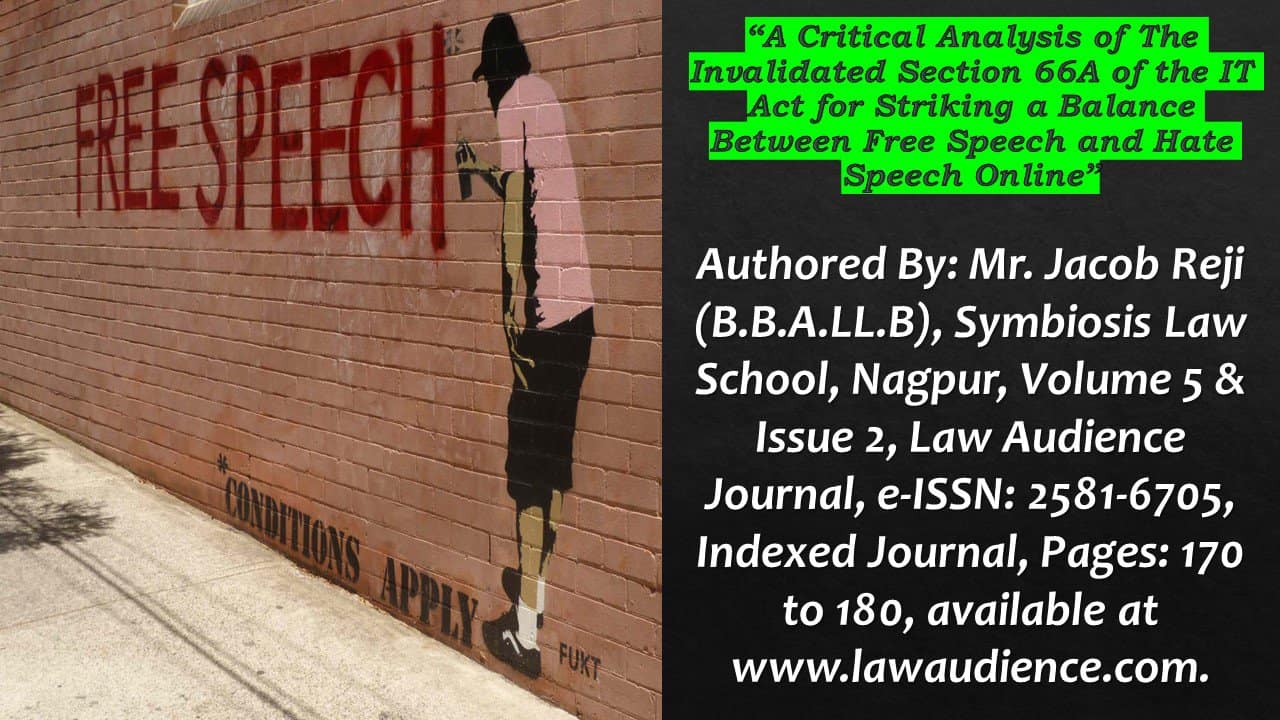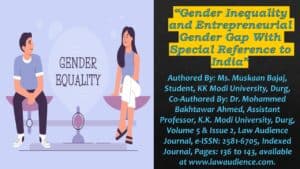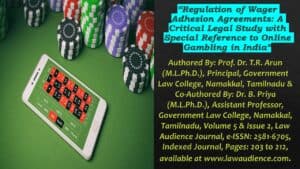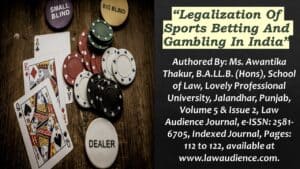Click here to download the full paper (PDF)
Authored By: Mr. Jacob Reji (B.B.A.LL.B), Symbiosis Law School, Nagpur,
Click here for Copyright Policy.
ABSTRACT
This paper attempts to analyse the developments and laws in the field of offensive messages/ hate speech through social media. The fluctuating stand of courts in India and various laws regarding this matter is the author’s primary concern areas.
India, the largest democracy in the world, ever since its independence strives to protect its people’s right to expression considering reasonable restrictions which are meant to protect the harmony among its people. In this 21st century where digital media plays a vital role in the field of communication; we must formulate rules and regulations to ensure that justice is being served. Developments in this field include invalidation of the 66A of the IT Act, complaints regarding the disproportionate serving of justice to the victims due to the unawareness of police and loopholes in the law and the lack of a straightforward law to regulate hate speech online. It is in this backdrop the author wishes to indulge in the discussions relating to 66A of the IT Act which once again came into the limelight when the Supreme Court, hearing the plea filed by PUVL, observed that it is “shocking” to hear that this provision is still used by the police even after the apex court invalidated the law. The author tries to address the situation before the enactment of 66A of the IT Act, how the proceedings changed after the enactment of this section and the legal consequences of committing similar crimes after striking down this section. The Author also made efforts to compare the similar provisions of various prominent jurisdictions.
I. INTRODUCTION
Benjamin Franklin once said- “Those who can give up essential liberty to obtain a little temporary safety deserves neither liberty nor safety”.
Ever since the inception of the Indian constitution, Freedom of speech and expression, defined under Article 19 (i)(a), has been considered a matter of supreme importance, keeping in mind that there are few limitations, under 19(2), enacted to maintain the communal and social harmony and security of its citizen.[1]
Chintaman Rao v State of M.P., the Court propounded that “reasonable restrictions” implies that the restraint imposed on a citizen in the enjoyment of the right shouldn’t be arbitrary or of an excessive nature, beyond what’s required within the interests of the general public[2]. These observations from the court put a burden on the state to formulate laws ensuring both rights are ensured.
With the number of smartphone users in India estimated to reach over 760 million by the end of this year, social media are becoming the main platform for people to voice their opinion. With expression and opinions in a digital platform curtained, the right of speech and expression and liberty to be informed, embedded in the former, also stands violated. Within the 30 years of social media’s life, its population has grown a million times over. The reason for its rapid growth is in the two main purposes it performs, the specific function of serving as a communications medium making end-to-end communications possible and the general function where it acts as an information system, allowing its users to create, store and access data. As Adam Smith noted, human beings have, “the natural propensity to truck, barter, and exchange one thing for another”[3]
“We are all regulated by software now. It has become possible to imagine that the most basic aspects of democracy, society, and even life itself might be regulated by software. The federal government has tried to regulate privacy, advertising, and pornography by software.” Thus, laws can be formulated to regulate online behaviour[4].
The second jurisprudential school of thought, advocated by Professor Jack Goldsmith and Tim Wu, proposes that cyberspace does not have a sui generis character and that current technological and legal instruments are sufficient to resolve disputes, like those that arise in the physical environment. This second jurisprudential school of thought didn’t support the local internet regulation[5].
II. Types of hate speech and legal framework:
Various forms of online hate speech, generally originating from an “us v them” framework trying to differentiate the group they belong to from an “out-group”, includes dehumanizing, demoralizing, incitement to violence etc.[6]
Information Technology Act, 2000 though aims to be a comprehensive enactment to govern online commerce it is not the sole enactment of it. General laws unless specifically excluded, as well as specific provisions found under other statutes, apply to online conduct equally. Further, the Information Technology Act, of 2000 though initially based on the MLEC has significant deviations from it. These deviations are in the form of complete chapters which have been included, in the process for enforcement of specific penalties mentioned under it as well as certain powers relating to security and surveillance etc.
II.I Few Provisions from Other Statutes:
- The IPC’s Section 354C safeguards women from voyeurism. According to this clause, violators who take pictures or recordings of a woman while she is performing a private act without her permission are subject to a fine and a prison sentence of one to three years.
- The IPC’s Section 354D addresses stalking in all its manifestations. If a guy continues to pursue a woman through any digital means without getting her permission, he could spend three years in prison if it’s a first-time offence. On subsequent offences, he might receive a five-year prison term. Whether it is his first or second offence, he may be required to pay a fine.
- Section 499 of the IPC covers defamation through social media or any electronic media and can be held responsible for two years imprisonment[7]. Section 499 had exceptions 2,3 dealing with fair commend, even exaggerated, but 66a has no such provisions.
- Anyone who threatens or intimidates women online with an anonymous message faces a two-year prison sentence under Section 507 of the IPC.[8]
- Those who publish vulgar comments on social media may be punished with a year in prison and a fine under Section 345A of the Indian Penal Code (IPC). Under the same law, sending or posting pornographic material without a woman’s consent carries a three-year prison[9].
- There are no specific laws that cover doxing and trolling.
- Sec 268- 66A borrows its phraseology heavily from 268 of IPC (public nuisance). But 66a is even applicable for private nuisance i.e. a civil suit can be shifted to a criminal case[10].
- The SC/ST (Prevention of Atrocities) Act was passed in 1989. In Gayatri v. State[11], the Court held that any offensive message posted on social media against a person belonging to SC/ST community could be held liable.
- Under Section 503 of the Penal Code, 1860 criminal intimidation is committed by any person who threatens to injure a person, property or reputation of any person or any person who is in the interest of another so as to compel one to do an act or to omit to do an act, provided this act or omission is against the law.
- “Intentional insult which can provoke breach of the peace” is required. held in Abraham v. State[12], for an offence under Section 504, what is material is not the reaction of the complainant but the intention of the offender to provoke or his knowledge that he is likely to provoke the person insulted. 66 A expressly uses the term criminal intimidation contained in sec 504 of IPC. Therefore, for innocuous comments made on the internet, if it’s no offence under 504, then it shouldn’t be an offence under 66A.
- Section 153A and section 505 of IPC can also be used.
III. SITUATION BEFORE THE ENACTMENT OF THE IT ACT:
Before the enactment of the IT Act provisions from the Indian Penal Code and various other statutes were used. Here are a few cases of that time.
- In Ram Lal Modi V State of UP case, the constitutionality of section 295 A of the IPC was confronted where the judge decided that the interest of the public order as envisaged in 19(2) included the maintenance of public order[13]. So even without a linkage between the impugned speech and possible outrage state can restrict its publication. The Bad Tendency test (developed in United States ex rel. Turner V Williams (1907) was used whereby any speech which could create a public order violation could be restricted. Deriving from the US legislation, this test only penalizes a deliberate and malicious intention of outraging the feelings of the class.
- Later, where the constitutionality of sedition laws (section 124A of IPC) was questioned, in Supt. Central Prison v. Ram Manohar Lohia, the court shifted its position and established the ‘proximate nexus’ test for regulating free speech in the interest of public order to exclude far-fetched, hypothetical or problematic and too remote cases from the ambit of “in the interest of public order”. [14]
- Later in Bilal Ahamed Kaloo V State of A.P. court observed that till the impugned speech or representation fails to create a conflict between two different classes, these sections are not attracted. The court tried to stick to the Ram Manohar Lohia case.
Above mentioned cases were all decided before the ’70s and are obviously not specific to online abuses and offensive comments. These case laws depict the court’s efforts in sticking a balance between free speech and restrictions.
III.I Enactment of IT Act,2000 and AMENDMENT:
The IT Act, 2000, provided legal recognition to the transactions carried out by the interchange of digital data hereinafter referred to as e-commerce. By 2016 this Act was further amended to widen its scope by introducing Information Technology Amendment Bill in Parliament. Though the Bill acquired legal status on 22nd December 2008, after it received Presidential assent and the Information Technology (Amendment) Act 2008, it came into force on 26th October 2009, after the notification by Central Government. The main objective of the ITAA, 2008, was to address the unresolved cyberspace concerns such as phishing, internet fraud etc., which though were one of the most vulnerable issues, but not covered under the previous legislation. The Act provides no specific definition of cybercrimes, nevertheless, it includes both cyber contraventions as well as cyber offences. The Act had been formed according to the United Nations Commission on International Trade Law model.
However, this amendment paved the way to a series of litigations for the said provisions were ambiguous and vague.
III.II Post enactment of IT (Amendment) Act, 2008:
- Posting ‘offensive’ messages on Twitter that Karti Chidambaram, son of then union minister P Chidambaram was ‘corrupt’.
- In 2013, a man in Agra was arrested for posting “offensive” cartoons on Prime Minister Manmohan Singh and two other leaders including SP leader Mulayam Singh Yadav. [15]
- In a few cases, the police acted wisely. For instance, in the controversy over Tanmay Bhat’s Snapchat video and said that it is not an offence and was posted with a dark taste of humour. [16]
- In Nanda Bholanath Singh v State of Maharashtra, the court granted anticipatory bail to the petitioner who had posted an allegedly defamatory post which can also be considered as an exception.[17]
- Another case dealing with 66-A was where Several Christian organisations also filed complaints that the show contained several religious comments and used insulting jokes on Catholics. The AIB Team later apologised to the Christian community for any hurt which was caused to their religious sentiments.
IV. THE SHREYA SINGHAL (2015) CASE AND OBSERVATIONS:
The next time 66A and related provisions came into the limelight was when 66A of the IT Act was held unconstitutional. 2012 case filed. 2013 apex court advisory a person accused of posting objectionable comments on social networking sites cannot be arrested without permission from the higher police authority. Now that the Supreme Court observed the widespread misuse of this invalid provision, it was obvious that the state would face setbacks. Here are the few developments and remarks of SC while hearing the PIL.
- The Central government asserted in the affidavit that, contrary to what the state claimed, “Prevention, detection, investigation, and prosecution of crimes and capacity-building of the police are primarily the responsibility of the States. “Unless a law is arbitrary and passed by an incompetent legislature, vagueness cannot be used as a justification for declaring it unconstitutional.
- A court can only intervene if a law openly violates a citizen’s rights under Part 3 of the constitution. [Para 6]
But the court stated that there cannot be any restriction unless there is incitement. Mere advocacy and discussion cannot be a ground to curtain the right to expression. [Para13]
The court also observed that 66A of the IT Act made no distinction between mere discussion and incitement by which there is imminent harm to public order and security of the state. [Para20]. When this section condemns any inconvenience to an individual, defamation laws are concerned with injury to reputation. [Para. 44]. The court also remarked that Section 66A was capable of having a chilling effect on the freedom of speech and expression and it is capable of curtaining a very large amount of protected and innocent speech. [Para. 83]. For these reasons, the apex court on February 26, 2015, apex court invalidated Section 66A of the IT Act.[18]
IV.I Post Shreya Singhal Situation:
Even after the invalidation of 66A of the IT Act, this section was widely used by the state to charge offences. Here are a few instances of how the court responded to such allegations.
- In 2016, a complaint was filed for reporting the pathetic condition of the storeroom of the state where the weapons and arms are stored. Under section 66A of IT Act, 500 and 501 of the penal code, 1860. Since 66A was held unconstitutional, no cognizable offence and FIR were squashed[19].
- In another case (FIR) was registered to allege the commission of an offence punishable under Sections 504, 507 and 509 of the Penal Code, 1860 read with Section 66(A) of the Information Technology Act, 2000. After the completion of the investigation, a charge sheet was filed by the Police the changes were only under the 66A of the IT Act. In accordance with the Shreya Singhal judgement, the petition was dismissed, and no charges were made under this section.[20]
- Section 153A of IPC, a non-bailable offence, was also invoked.
V. Similar Provisions of Famous Jurisdictions
UK
The UK has devised many laws to tackle the different forms of social media abusive behaviours including cyberbullying, revenge porn, trolling, virtual mobbing etc. Here is the list of a few prominent laws enacted
- Under Section 127 of the Communications Act 2003 it’s an offence to send a message or other matter that is “grossly offensive” or of an indecent, or menacing character through electronic media. This same section also provides that it is an offence to send or false message “for the purpose of causing annoyance, inconvenience or needless anxiety to another”.
- Under section 44-46, serious crimes act 2007, a person encouraging others to send offensive messages to initiate virtual mobbing could be held liable.
- Sections 2A and 4A of the Protection from Harassment Act 1997 respectively prohibit stalking and conduct relating to stalking which involves fear of violence, serious alarm or distress. Section 2 of the same act defines harassment.
- Section 103 of the Digital Economy Act 2017 requires the authority to issue guidelines to be followed by social media providers to be taken in case of bullying and intimidating behaviours on their sites.[21]
US
The US Constitution gives at most importance to the right to free speech so that any legislation against this i.e., restrictions is subject to tight scrutiny. The first amendment of the United States Constitution prohibits the constraint of free speech by the public authority. The first amendment nevertheless does not prevent social media platforms from imposing their own limitations. These platforms are protected from private litigation as they aren’t recognised as publishers under section 230 of the Communications Decency Act, 1996.[22]
Section 230 of the Communications Decency Act makes internet service -providers liable for derogatory statements and gives them the right to “restrict access to or availability of material that the provider or user considers to be obscene, lewd, lascivious, filthy, excessively violent, harassing, or otherwise objectionable” without being held liable for user content.[23]
Few other provisions of US Jurisdiction
- Part I, chapter 13 title 18 US section 249 – Hate crime acts deal with offences relating to the invasion of privacy and illegal and harmful speech
- Title 18, Part I of Chapter 121 under section 2701, addresses online-related offences and has penal provisions for intentional invasion of online privacy of another’s personal data which also includes posting an “offensive message” on social media platforms.
- Title 18, Part I under Chapter 88, section 1801 prohibits video voyeurism.
- Title 18 Part I of Chapter 121 in Section 2708 provides civil remedies for breach of confidence and invasion of privacy. [24]
VI. INTERNATIONAL REGULATORY NETWORKS:
- INHOPE is the Association of Internet Hotlines, coordinating all similar holiness around the globe, which provides a mechanism for receiving complaints about alleged illegal content on the internet. Hotlines need the support of the government, industry, law enforcement, and Internet users in the countries of operation.[25]
- The International Network Against Cyber Hate (INACH), through a network of 18 organizations, works to address all forms of online discrimination in different parts of the globe. They have done significant work in collecting information from different countries, facilitating meetings and encouraging sharing of information as well as offering their own expertise on the issue of cyberhate.
VII. CONCLUSION:
Richard Von Weizsacker, the former President of Germany once said – “Democracy feeds on arguments, on the discussion as to the right way forward This is the reason why respecting the opinion of others belongs to democracy”.
These words reiterate the importance of attaining a fine balance between free speech and related restrictions.
Reports from Ditch the Label and Brandwatch suggests that there were almost 5 million cases of misogyny on Twitter alone, 7.7 million cases of racism, 3,90,296 instances of homophobia and 19348 transphobic messages sent on Twitter. Extrapolating this data so as to include other social media and private chats the level of online abuse is overwhelming.[26]
At the time of the CAA protests, one among the furious debates was on the comments passed by famous people including the then home minister’s statement “push the button so hard that the shock is felt in Shaheen Bagh” and “Asadi’ slogans from the student protesters. The question of contention was whether their remarks cross the threshold and it received mixed responses and different treatment from the law. According to Abhinav Chandrachud, advocate, the Bombay High Court there is a need of developing a standard test, maybe one similar to that formulated by Justice Oliver Wendell Holmes of the U.S Supreme Court. The test was that, if you cannot argue with a man making the statement then it’s inflammatory. For example, one shouts “fire” in a crowded theatre. However, if there is a scope for arguments, that speech should be protected under free speech. The issue arises in the instance that what if the debate is one-sided. Up to what extent do these rules get applied?[27]
In this particular scenario comes the need for an effective law. Laws regulating online media abuse are an absolute necessity in a society where almost everyone uses and more precisely actively uses social media to express their opinions. Parliament should come up with more inclusive and well-researched laws and restrictions to maintain harmony among the citizens. We don’t need more draconian laws but definitely need laws that are not capable of misinterpretation and misuse. Parliament should take the lead to formulate the law in such a way that they leave very less scoop for interpretation.
Cite this article as:
Mr. Jacob Reji, “A Critical Analysis of The Invalidated Section 66A of the IT Act for Striking a Balance Between Free Speech and Hate Speech Online”, Vol.5 & Issue 2, Law Audience Journal (e-ISSN: 2581-6705), Pages 170 to 180 (30th July 2023), available at https://www.lawaudience.com/a-critical-analysis-of-the-invalidated-section-66a-of-the-it-act-for-striking-a-balance-between-free-speech-and-hate-speech-online.
Footnotes & References:
[1] Amnesty International, “Freedom of Expression” http://www.amnestyusa.org/our-work/issues/censorship-and-free-speech
[2] Chintaman Rao v. State of M.P.(AIR 1951 SC 118)
[3] Adam Smith, An Inquiry into the Nature and Causes into the Wealth of Nations 22 (Edwin Cannan ed. 2003)
[4] Grimmelmann, James. “Regulation by software.” Yale LJ 114 (2004): 1719
[5] Goldsmith, Jack L., and Alan O. Sykes. “The Internet and the dormant commerce clause.” Yale LJ 110 (2000): 785
[6] Baker Bahador, Professor, George Washington University, Classifying and identifying the intensity of Hate speech https://items.ssrc.org/disinformation-democracy-and-conflict-prevention/classifying-and-identifying-the-intensity-of-hate-speech/ – :~:text=Hate%20speech%2C%20of%20course%2C%20is,demonization%2C%20and%20incitement%20to%20violence.
[7] Id, s 499
[8] Id, s 507
[9] Id, s 345A
[10]Id, s 268
[11] Gayatri v State and Ors. MANU/DE/1823/2017
[12] Abraham v. State And Anr. AIR 1960 Ker 236
[13] Ramji Lal Modi v. State of U.P., AIR 1957 SC 620 : 1957 SCR 860.
[14] Supt., Central Prison v. Ram Manohar Lohia, AIR 1960 SC 633 : (1960) 2 SCR 821
[15] Agra men held for facebook post on PM, DNA. http://dnaindia.com/india/report-agra-man-held-for-facebook-posts-on-pm-kapil-sibal-mulayam-singh-1796456
[16] Shiromani Gurudwara Prabandhak Committee v. Union of India, (1986) 3 SCC 600
[17] Nanda Bholanath Singh v State of Maharashtra, 2017 SCC OnLine Bom 1381
[18] Shreya Singhal v Union of India (2015) 5 SCC 1
[19] Tarakant Devnarayan Dwivedi v. State of Maharashtra, 2016 SCC OnLine Bom 14471
[20] Sanjay Prabhakar Gadekar v. State of Maharashtra, 2017 SCC OnLine Bom 4684
[21] Social-media and criminal offences- Communications Committee, CHAPTER 2: Social Media and the Law www.parliament.uk https://publications.parliament.uk/pa/ld201415/ldselect/ldcomuni/37/3704.htm
[22] O’Regan, Catherine. “Hate speech Online: An (intractable) contemporary challenge?” Current Legal Problems 71.1 (2018): 403-429.
[23] David French, The growing threat to Free speech Online, TIME https://time.com/5770755/threat-free-speech-online/
[24] The Cornell University of Law, ‘Hate crime acts’ (Legal Information Institute) http://www.law.cornell.edu/uscode/text/18/249
[25] British institute of human rights (2012), Mapping study on a project against hate speech, Council of Europe
[26] Ditch the label and Branwatch, “Cyberbullying and hate speech: What can social data tell us about hate speech online” http://www.ditchthelabel.org/research-papers/the-annual-bullying-survey-2016/
[27] Jayant Sriram Should restriction on free speech be reviewed, THE HINDU https://www.thehindu.com/opinion/op-ed/should-restrictions-on-free-speech-be-reviewed/article30694970.ece.



